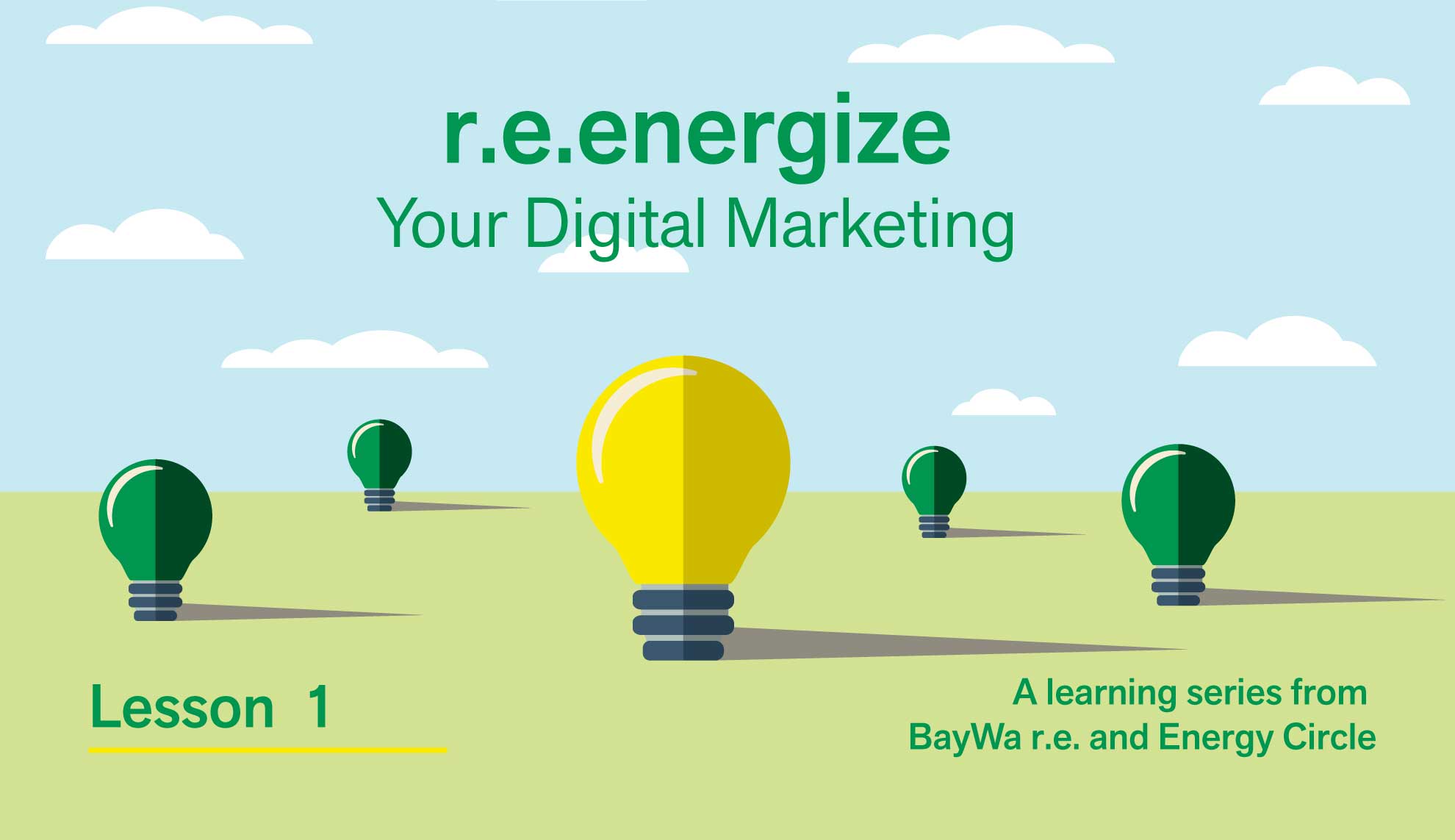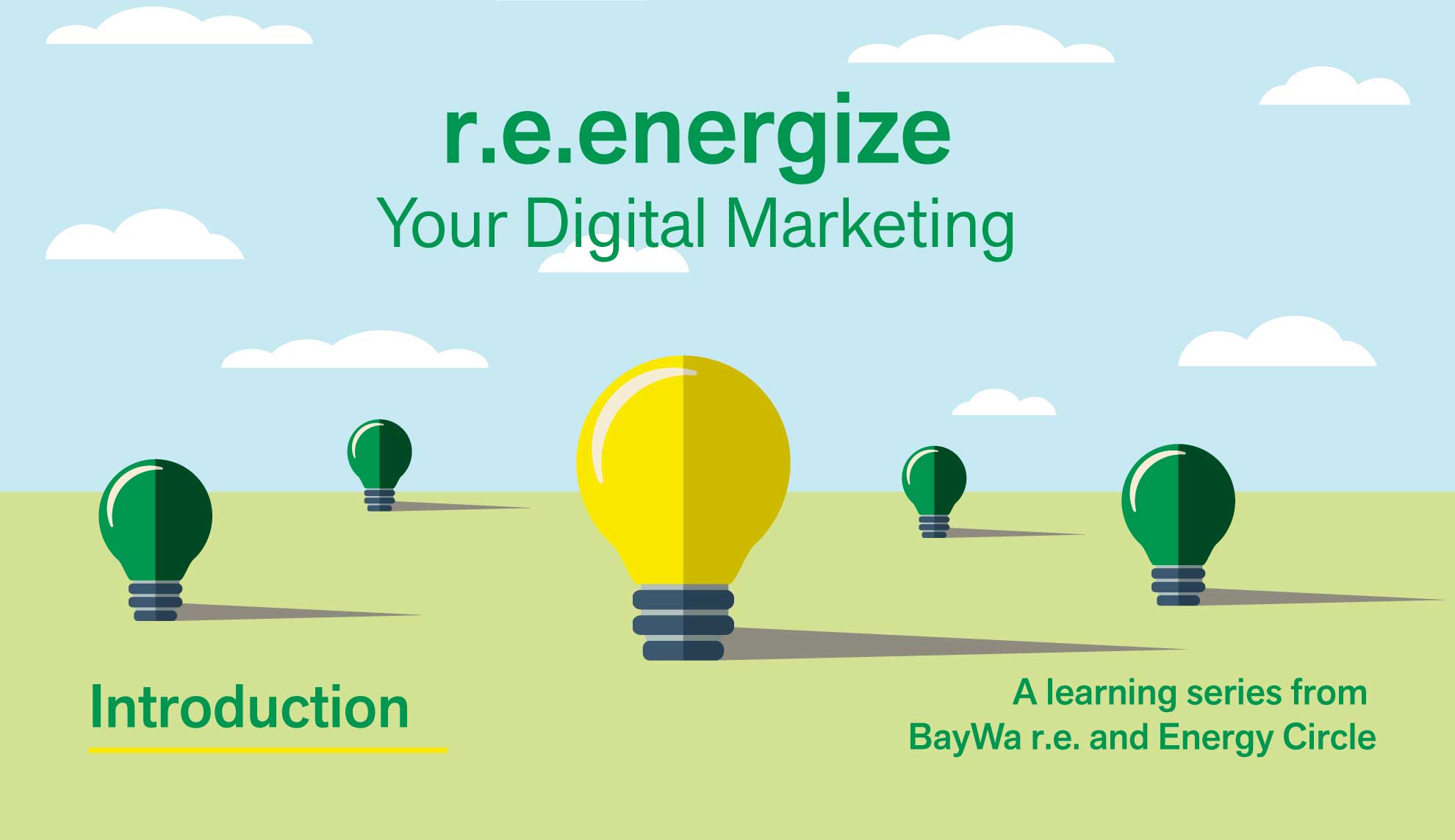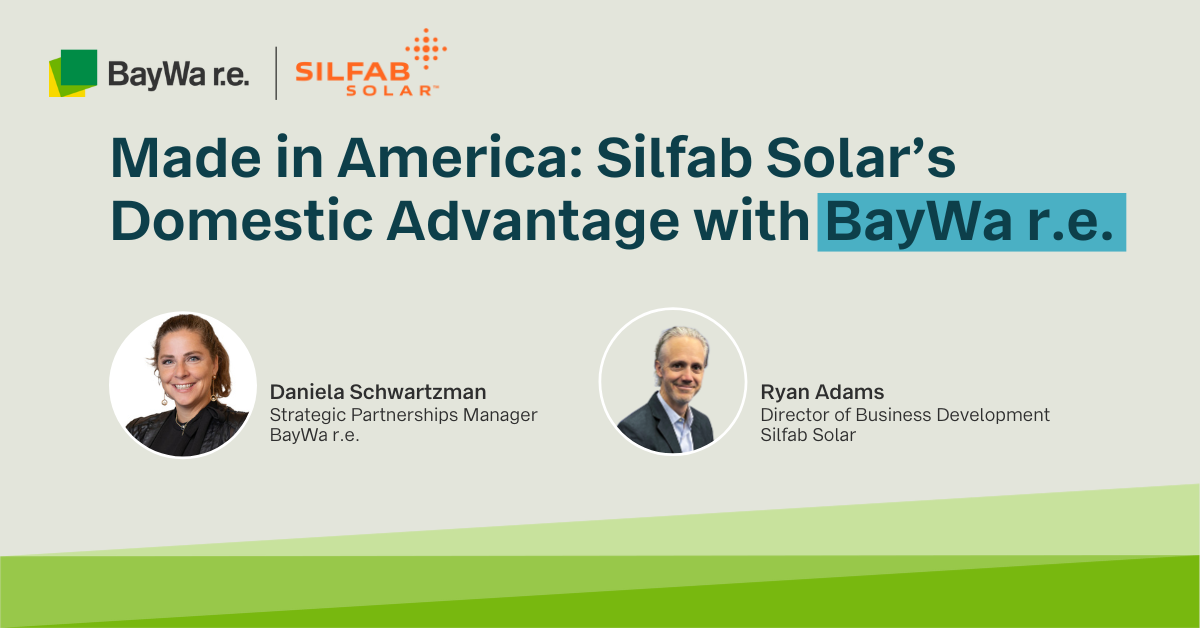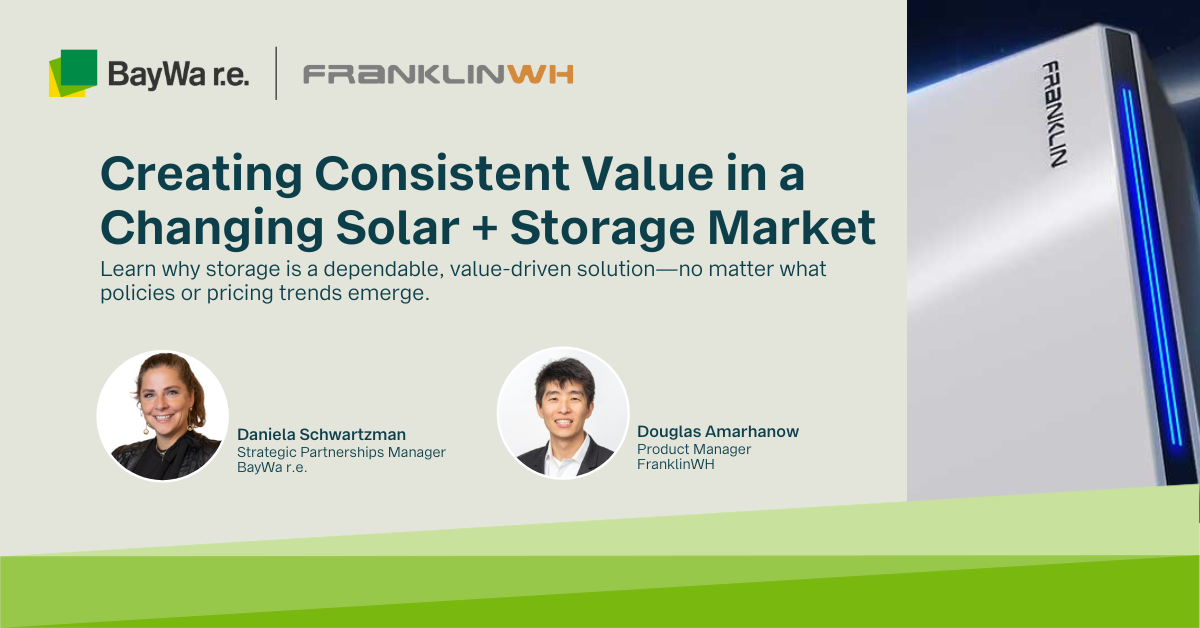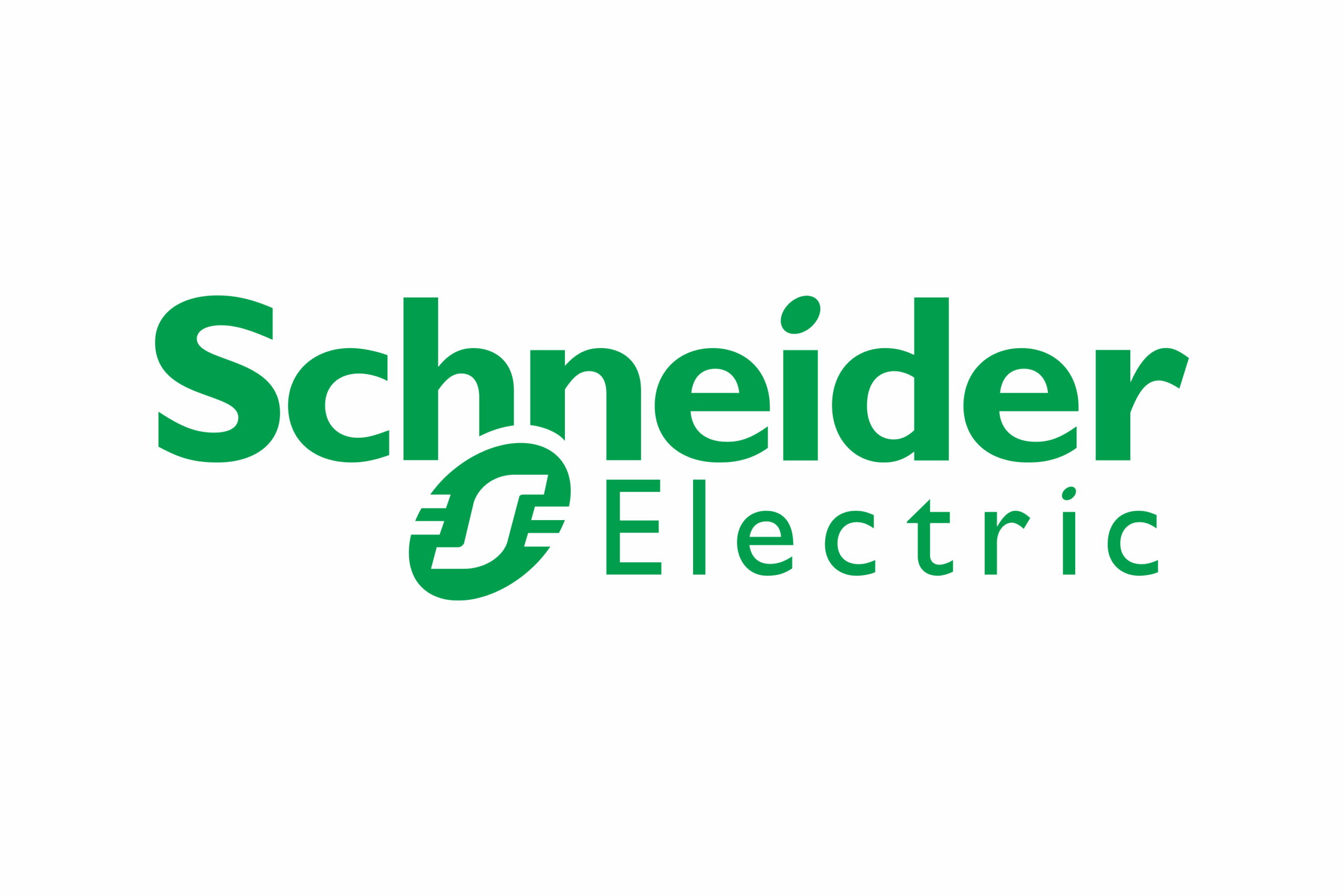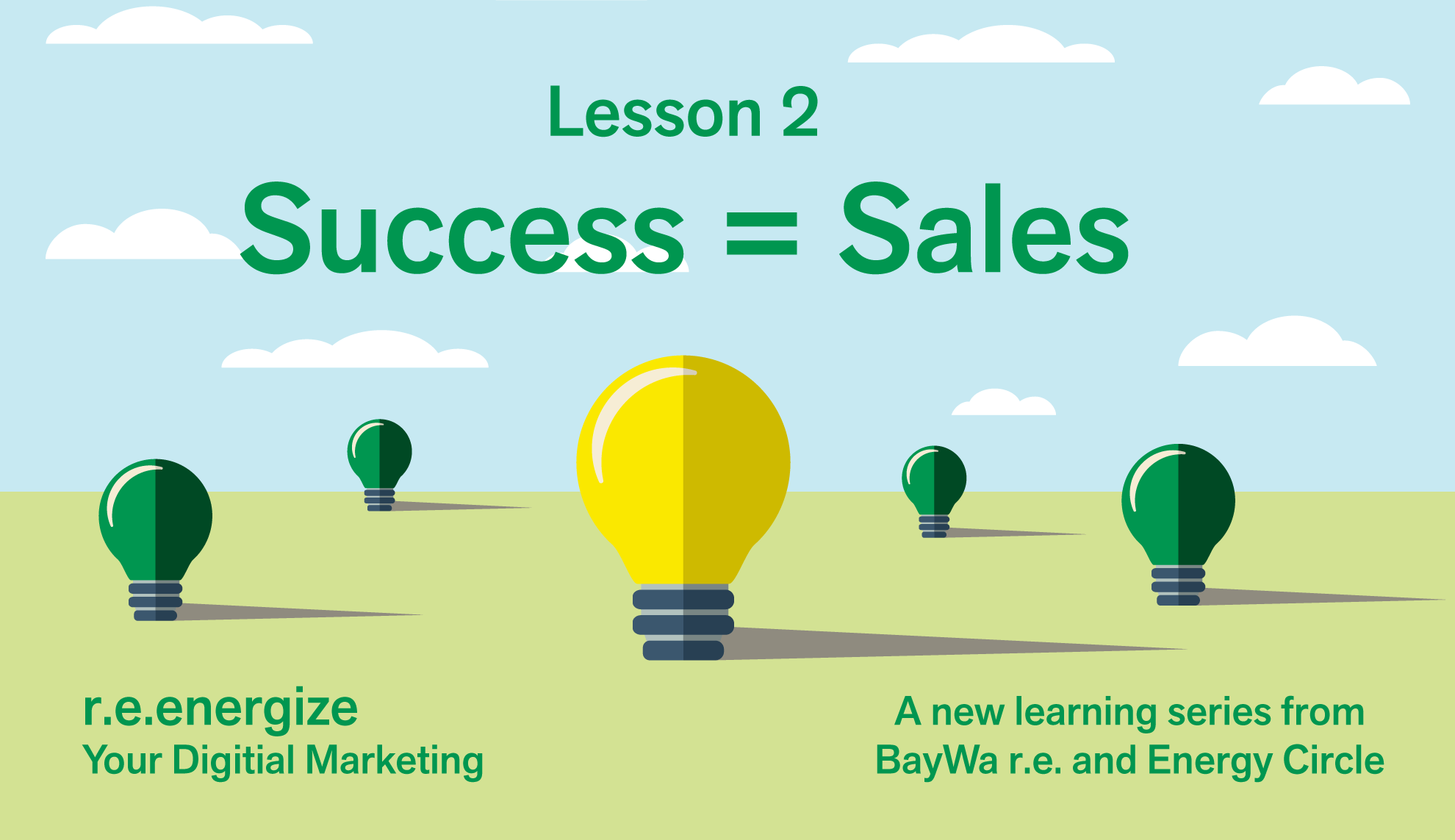
Note: This article is part of the educational series: r.e.energize Your Digital Marketing. To view all the lessons in the series, click here.
UPCOMING EVENT: Each section of the r.e.energize Your Digital Marketing series will have an in-depth live training and a special offer for BayWa r.e. customers who register. Our first live training is on January 15th at 4 pm EST and is entitled: “6 Key Trends for Residential Solar Lead Generation in 2019”.
Article overview
In this article, we’ll focus on the most important part of building or optimizing a digital marketing campaign: defining success. Defining what success looks like for your marketing is a critical first step. Without it, there is a high likelihood that your campaign will fail, as there is no clear goal or objective metric for course correction once you get going.
This article is for 1) residential solar contractors, especially those investing in digital marketing in 2019, and 2) those who need to understand if their campaigns are working or not.
In this article, we will discuss:
- How to define success in digital marketing. What is the best “success metric?” And how to know if that metric is successful?
- The difference between success metrics and leading indicators. (This one is critical, as folks often spend too much time on leading indicators.)
Success equals sales
The majority of digital marketing is a direct response medium because it is dominated by internet searches from consumers looking to buy things. Given this, the primary success metric in digital marketing for residential solar digital marketing is going to be: sales. In other words, the “filter” that determines which campaigns, activities, dollars, are successful or not is always going to be sales.
Since success equals sales, every digital campaign should be tied directly to sales. All other metrics are leading indicators.
Definition: A leading indicator, in this case, is something that tends to lead to sales, but is not necessarily going to lead to sales. (We’ll discuss common leading indicators below.)
A critical element to all this is to have tracking set up between your marketing and sales channels. This means that you have a CRM (Salesforce, Netsuite, etc.), which allows you to tag leads accurately. Once this is done, you will be able to filter sales by lead source.
What is a good cost-per-sale number?
You need to determine what a good cost-per-sale number is for your business. No one can figure this out for you.
A good cost-per-sale number is determined by:
- Company size. The larger the company, the higher the cost per sale. (See graph below.)
- Desired growth rate vs. industry growth rate. The faster you want to grow against the industry growth rate, the more expensive it will be, all else being equal. If the industry in your area is growing at 30%, and you wish to grow at 50%, it will be more expensive than if your goal is to grow at 20%.
- Internal efficiency and overhead. Companies that have high gross margins and/or lower overhead can afford to spend more on marketing than those that are less operationally-efficient. They might not want or need to spend more on marketing, but their high gross margins mean they have the option to spend more while remaining profitable.
- Referral rate. Companies with higher referral rates can grow faster while keeping a lower target cost per sale.
- Referral rate itself is a function of a) number of customers, b) customer experience, and c) branding.
The fun part is that each of these variables feeds back into the others. Here are some industry data for perspective.
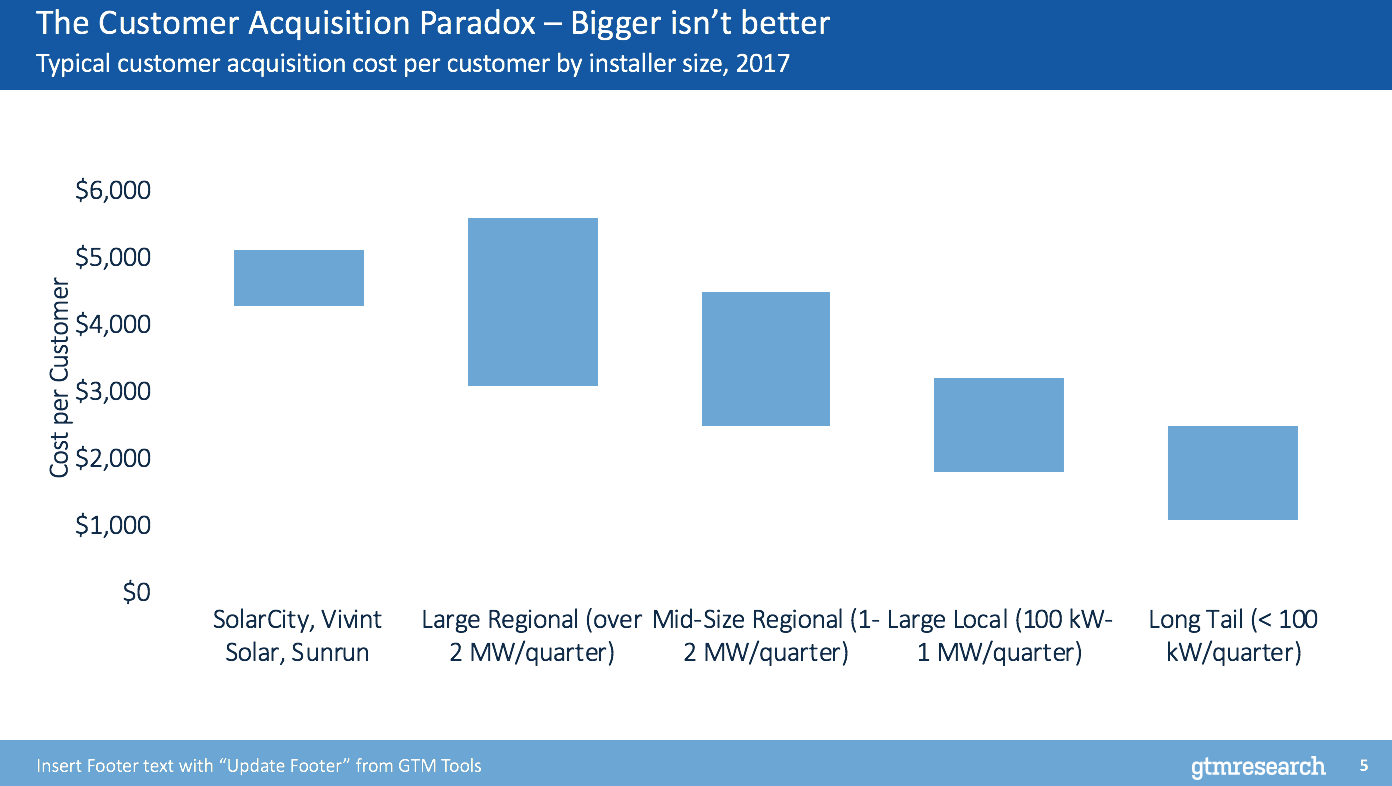
Also note that when we look at the total cost per sale, it’s imperative to calculate all of your sales costs.
Let’s take a look at some numbers, based on work I have done with numerous solar contractors.
| Channel | Leads | Cost Per Lead | Sit Rate | Appointments | Close Rate | Sales |
|---|---|---|---|---|---|---|
| Purchased | 200 | $30 | 10% | 20 | 15% | 3 |
| Referral | $50 | $0 | 90% | 45 | 50% | 22 |
| Events | 30 | $200 | 80% | 24 | 30% | 7 |
| Website/Digital | 50 | $100 | 80% | 40 | 25% | 10 |
| Total/Average | 330 | $55 | 65% | 129 | 30% | 42 |
| Marketing Cost | Marketing CPS | Inside Sales Cost | Inside - CPS | Outside Sales Cost | Outside CPS | Total Cost Per Sale | |
|---|---|---|---|---|---|---|---|
| Purchased | $6,000 | $2,000 | $1,500 | $500 | $4,300 | $1,433 | $3,993 |
| Referral | $500 | $500 | $375 | $22 | $18,825 | $855 | $1,752 |
| Events | $6,000 | $857 | $231 | $33 | $7,200 | $1,028 | $1,918 |
| Website/Digital | $5,000 | $1,000 | $375 | $37.50 | $11,000 | $1,100 | $2,475 |
| Average | $964 | $148 | $1,100 | $2,409 |
- Marketing Cost: Cost is included as either direct cash expense or cost for person-hours.The cost-per-lead is calculated by dividing the number of leads by the spend for a channel.
- Purchased Leads: Assuming a $30 cost-per-lead.
- This is on the low end, but I’ve heard these prices are increasing.
- Referral: No cost-per-lead, but assuming a $500 success fee.
- Events: Assuming that a $6,000 spend in labor ($60/hour, 100 hours, total across 3 events) will generate 30 leads.
- Digital: Assuming that a $5,000/month digital spend in paid search, content, SEO, and website optimization, will generate 50 leads, meaning the cost-per-lead is $100.
- Purchased Leads: Assuming a $30 cost-per-lead.
- Inside Sales Cost: Person-hours required to turn leads into appointments.
- We assume it costs $7.50 to process each lead to get to a specific appointment rate.
- Each lead must get 5 calls within two weeks to get the maximum appointment sit rate
- Labor cost is $30/hour
- Can make 20 calls an hour
- Thus, processing 100 leads is 500 calls and takes 25 hours
- 25 hours costs $750
- $750 for 100 leads is $7.50 per lead
- This is the methodology; adjust these for your company.
- We assume it costs $7.50 to process each lead to get to a specific appointment rate.
- Outside Sales Cost: Cost and person-hours required to turn appointments into sales.
- Commision is $600 per sold job
- Each appointment costs $125
- 2 appointments per day on average
- Base = $25/hour, $200/day, $100 per appointment
- Mileage is 90 miles per day at $0.55/mile — $55 in mileage, $25/appointment
Additional reading: Barry Cinnamon has some great perspective on these costs with a lot of specific numbers in “Can Residential Installers Make a Profit from Solar at $2.50/Watt”.
Key items for defining success
- What exactly is your marketing cost-per-sale?
- You need to figure that number out for yourself. This is not something that I can tell you. I can give you examples and methodology, but each company must figure this out for themselves.
- In addition to that specific number, you need to figure out a few more things.
- Is this marketing cost a blended average of all digital channels, OR is there a hard ceiling for any specific channel?
- For example, the target cost-per-sale for marketing costs might be $1,300 from all digital channels. This means it’s okay to have SOME channels that are $2,000, as long as all channels average out at $1,300 over a stated period of time.
- Keep in mind that time period is very important for this.
- However, you might also have a hard ceiling, where the target cost-per-lead is the CEILING, and you won’t accept any digital channel where the cost-per-sale is above this.
- Which one you choose is based on your business strategy, you’ll need to figure this out for yourself.
- For example, the target cost-per-sale for marketing costs might be $1,300 from all digital channels. This means it’s okay to have SOME channels that are $2,000, as long as all channels average out at $1,300 over a stated period of time.
- How many leads do you need per month?
- It’s less expensive on a per-lead-basis to generate more leads on a monthly basis, rather than fewer. The cost-per-lead tends to decrease faster with the more leads you’re looking to get, for two reasons:
- Economies of scale. For example, with paid search marketing, one can double their ad spend with only marginally increase management fees. With content marketing, the cost-per-article decreases the more that are purchased. More content almost always means more organic traffic.
- More data = more optimizations, faster. With more data, you can run more marketing tests and optimize your campaigns faster.
- It’s less expensive on a per-lead-basis to generate more leads on a monthly basis, rather than fewer. The cost-per-lead tends to decrease faster with the more leads you’re looking to get, for two reasons:
- How long are you willing to invest?
- Digital marketing can be successful. This is a known fact. The question is, how long are you willing to invest?
- If your time frame is less than 6 months, don’t invest in digital. It takes longer than that time frame to get a large enough sample size to work on it.
- The best scenario is that you bought into digital marketing because you believe it’s critical for the next 10 years, and you’re just figuring out the best way to implement it.
- You still need to course-correct; the issue is whether you trust that it can be figured out.
- Digital marketing can be successful. This is a known fact. The question is, how long are you willing to invest?
Leading Indicators
Once it’s clear that success equals sales, it’s important to identify the most critical leading indicators to most likely lead to sales. I use the term “most likely” because this is not always the case—that’s why it’s a leading indicator.
Common leading indicators
- Cost-per-lead, “CPL”
-
- Cost-per-lead is what it costs to get someone to call you, or reach out through your website, looking for a quote.
- This is different from a booked appointment. (A booked appointment is when a salesperson meets the homeowner at their house.)
- It’s a leading indicator because leads might not close, so having a lot of leads and/or a low cost per lead is USUALLY a good thing—though that’s not always true.
- Why is it important to understand that CPL is a leading indicator and not a success metric? Two reasons:
- When you see a very low cost-per-lead, double-check that leads are actually closing. If they are not closing, they are not valuable, even if they are cheap!
- When you see a very high cost-per-lead, double-check that leads are not closing. Even if leads are expensive, if they close at a high rate, and/or close quickly, they can be very valuable.
-
- Cost-per-click, “CPC”
- A simple definition of cost-per-click is the cost to get a single click on your website.
- Cost-per-click is most commonly used in an analysis of paid search campaigns.
- All else being equal (“all else” meaning: landing page conversion and lead conversion rates), a lower cost-per-click is always better. The thing is, “all else” is rarely ever equal. For example, you can have a very low cost-per-click, but very high cost-per-lead, and cost-per-sale.
- You can learn more about paid search in this free training on Finding Profitable Keywords in Solar.
Other leading indicators that are focused on less often
- Website traffic. The total amount of traffic to your website. More is typically better, but you could be attracting the wrong traffic, so this isn’t always a great indicator.
- Conversion rate. Conversion rate is the number of leads generated from your website divided by the amount of traffic in a certain amount of time. If your website generates 10 leads for every 100 visitors, it has a 10% conversion rate. A higher conversion rate is almost always better, as long as the leads themselves are quality leads (quality meaning that they actually convert into sales).
- Ranking keywords. The number of organic keywords that show up within the top 50 keywords every time this keyword is searched. Typically, the more ranking keywords you have, the better. However, this assumes that they are the right keywords. We’ll discuss what are the ‘right keywords’ later.
- Price-per-click ad position. When you’re bidding on a campaign, do you show up 1st, 2nd, or 3rd in the Google SERP (Search Engine Results Pages)? Higher is typically better because the higher you are, the more clicks you’ll get. More clicks equal more leads. However, it can be costly to show up high on the SERP. Sometimes you can even get a far better cost-per-lead with a lower page position—then you can use the extra money to bid on other keywords.
Strategically, when should you focus on digital?
Energy Circle has customers who have invested in digital, primarily to enhance the effectiveness of other channels. Along these lines, let me share a short digital story I’ve heard over and over again: A company generates a lead from canvassing, purchases a lead, OR gets a lead from a face-to-face event. The homeowner had researched the company but couldn’t find them easily online, so it negatively impacted the sale because it decreased trust that they were a legitimate business. Even though they were standing in front of a person, either at a marketing event or in a salesperson in someone’s home, the fact they couldn’t be found online was a red flag for the homeowner.
This story highlights a critical element: almost all the people in your sales funnel will research you online before buying. Thus, digital enhances all other marketing channels because consumers that enter your sales funnel from those channels will research you online before buying. If you can’t easily be found online—and look good—those other channels will suffer. This brings up back to our key question for this section: WHEN is the best time to focus on digital?
While the answer is based on your specific business context, I can provide a number of questions to help you figure out if now is the right time.
Here are two common questions to ask when deciding whether you should invest in digital or not.
- What are your growth goals?
- How do your growth goals compare to the industry? The higher your growth goals, the more leads you’ll need, so you’ll need to factor in your confidence in your existing channels. If your growth goals are the same, or lower than the industry, you likely won’t need to invest as much in marketing since there will be enough demand. But if your goals are higher than the industry’s, you’ll need to invest more heavily in marketing.
- How confident are you that you can achieve your goals with your existing channels?
- What is your existing channel performance?
- Are you confident that your existing channels can increase lead generation to achieve your existing goals?
- If yes, invest and optimize those channels first. This is always easier.
- If not, consider investing in your digital presence. It will enhance those channels for the reasons we talked about above—even if only marginally—and will also generate leads directly.
- Are you confident that your existing channels can increase lead generation to achieve your existing goals?
Summary
To define success in digital marketing, you need to be very specific and answer the following questions:
- What is the target cost-per-sale on marketing? For this, you need a specific number.
- What is the total cost-per-sale for all sales and marketing? You need to figure this out.
- Is the target cost-per-sale on marketing blended or ceiling? This is critical for analyzing success and optimizing.
- How many leads do you want per month? This will determine how much to invest.
- How long can you invest before analysis and optimization?
Continue learning
